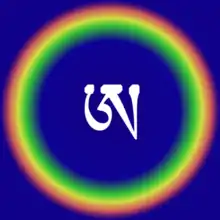Rainbow body
In Dzogchen, rainbow body (Tibetan: འཇའ་ལུས་, Wylie: 'ja' lus , Jalü or Jalus) is a level of realization. This may or may not be accompanied by the 'rainbow body phenomenon'. The rainbow body phenomenon is a topic which has been treated fairly seriously for centuries, including in the modern era. Other Vajrayana teachings also mention rainbow body phenomena.
Rigpa

The rainbow body phenomenon is a third person perspective of someone else attaining complete knowledge (Tibetan: རིག་པ, Wylie: rigpa ). Knowledge is the absence of delusion regarding the display of the basis.
Rigpa has three wisdoms, which are kadag, lhun grub and thugs rje. Kadag deals with tregchöd.[2] The lhun grub aspect has to do with esoteric practices, such as (but not limited to) Thödgal, that self-liberate the human body into a Sambhogakāya (rainbow body phenomenon).[2][3] The symbol of Dzogchen is a Tibetan "A" wrapped in a thigle. The "A" represents kadag while the thigle represents lhun grub. The third wisdom, thugs rje (compassion), is the inseparability of the previous two wisdoms.
In Dzogchen, a fundamental point of practice is to distinguish rigpa from sems (mind).[4]
The ultimate fruition of the thodgal practices is a body of pure light, called a rainbow body (Wylie 'ja' lus, pronounced ja lü.)[5] If the four visions of thogal are not completed before death, then during death, from the point of view of an external observer, the dying person starts to shrink until he or she disappears. Usually fingernails, toenails and hair are left behind[6] (see e.g. Togden Ugyen Tendzin, Ayu Khandro, Changchub Dorje). The attainment of the rainbow body is typically accompanied by the appearance of lights and rainbows.[5]
Exceptional practitioners are held to realize a higher type of rainbow body without dying. Having completed the four visions before death, the individual focuses on the lights that surround the fingers. His or her physical body self-liberates into a nonmaterial body of light (a Sambhogakāya) with the ability to exist and abide wherever and whenever as pointed by one's compassion.[7]
Eyewitness account
Shardza Tashi Gyaltsen's Heart Drops of Dharmakaya, a Kunzang Nyingtik Dzogchen meditation manual commentated on by Lopon Tenzin Namdak, contains an eyewitness account of his main students' bodies shrinking and rainbows appearing in the sky at death.[8]
List of those reported to have attained the rainbow body
- Shardza Tashi Gyaltsen (1935)
- Sodnam Namgyal (1952)[9]
- Ayu Khandro (1953)[10]
- Kenchen Tsewang Rigdzin (1958)[11]
- Togden Ugyen Tendzin (1962)[12]
- Khenpo A-chos (1998)[13]
Notes
- Norbu 2002, p. 56.
- Garry 2005, p. 296.
- Dalai Lama 2004, p. 32.
- Kunsang 2012, p. 154.
- Ray 2001, p. 323.
- Norbu 1999, pp. 158-161.
- Rangdrol & Matthieu 2001, p. 153.
- Gyaltsen 2002, pp. 135-137.
- Rabjam, Thondup & Talbot 1996, pp. 137–139.
- Allione 2000.
- Nyoshul Khenpo 2005, pp. 472–474.
- Norbu 2012.
- Holland 2002.
References
- Allione, Tsultrim (2000). Women of Wisdom. Ithaca, New York: Snow Lion Publications. ISBN 9781559391412.CS1 maint: ref=harv (link)
- Dalai Lama (2004). Dzogchen: Heart Essence of the Great Perfection. Snow Lion Publications. ISBN 978-1-55939-219-8.CS1 maint: ref=harv (link)
- Garry, Ron (2005). Wisdom Nectar: Dudjom Rinpoche's Heart Advice. Ithaca, New York: Snow Lion Publications. ISBN 9781559399517.
The practice is that of Cutting through Solidity (khregs chod), which is related to primordial purity (ka dag); and Direct Vision of Reality (thod rgal), which is related to spontaneous presence (Ihun grub).
CS1 maint: ref=harv (link) - Gyaltsen, Shardza Tasha (2002). Heart Drops Of Dharmakaya: Dzogchen Practice Of The Bon Tradition (2nf ed.). Snow Lion Publications. ISBN 978-1559391726.CS1 maint: ref=harv (link)
- Holland, Gail (March–May 2002). "Christian Buddhist Explorations: The Rainbow Body". Institute of Noetic Sciences Review. Institute of Noetic Sciences (59).CS1 maint: ref=harv (link)
- Kunsang, Erik Pema, tr. (2012). Perfect Clarity: A Tibetan Buddhist Anthology of Mahamudra and Dzogchen. Ranjung Yeshe Publications. ISBN 978-9627341697.CS1 maint: ref=harv (link)
- Norbu, Chögyal Namkhai (1999). The Crystal and The Way of Light: Sutra, Tantra and Dzogchen (New ed.). Ithaca, New York: Snow Lion Publications. ISBN 1-55939-135-9.CS1 maint: ref=harv (link)
- Norbu, Chögyal Namkhai (2002). Dream Yoga and the Practice of Natural Light (Rev. Exp. ed.). Snow Lion Publications. ISBN 978-1559391610.CS1 maint: ref=harv (link)
- Norbu, Chögyal Namkhai (2012). Rainbow Body: The Life and Realization of a Tibetan Yogin, Togden Ugyen Tendzin. North Atlantic Books. ISBN 978-1583944912.CS1 maint: ref=harv (link)
- Nyoshul Khenpo (2005). A Marvelous Garland of Rare Gems: Biographies of Masters of Awareness in the Dzogchen Lineage. Padma Publications.CS1 maint: ref=harv (link)
- Rabjam, Longchenpa; Thondup, Tulku, tr.; Talbot, Harold, ed. (1996). The Practice of Dzogchen (2nd ed.). Ithaca, New York: Snow Lion Publications. ISBN 1-55939-054-9.CS1 maint: extra text: authors list (link) CS1 maint: ref=harv (link)
- Rangdrol, Shabkar Tsogdruk; Matthieu, Richard, tr. (2001). The Life of Shabkar: The Autobiography of a Tibetan Yogin. Ithaca, New York: Snow Lion Publications. ISBN 978-1559391542.CS1 maint: ref=harv (link)
- Ray, Reginald (2001). Secret of the Vajra World: The Tantric Buddhism of Tibet. Shambhala Publications. ISBN 9781570627729.CS1 maint: ref=harv (link)
Further reading
- Blackman, Sushi, ed. (1997). Graceful Exits: How Great Beings Die: Death Stories Of Tibetan, Hindu & Zen Masters. New York: Weatherhill, Inc. ISBN 0-8348-0391-7.CS1 maint: ref=harv (link)
- Norbu, Chögyal Namkhai (1988). Shane, John (ed.). The Crystal and the Way of Light: Sutra, Tantra and Dzogchen: The Teachings of Namkhai Norbu (1st ed.). Routledge & Kegan Paul. ISBN 0-14-019084-8.CS1 maint: ref=harv (link)
- Reynolds, John Myrdhin (1996). The Golden Letters (1st ed.). Ithaca, New York: Snow Lion Publications. ISBN 978-1559390507.CS1 maint: ref=harv (link)
- Sogyal Rinpoche (1993). Harvey, Andrew; Gaffney, Patrick (eds.). Tibetan Book of Living and Dying (Rev. and Updated ed.). HarperSanFrancisco. ISBN 978-0-06-250834-8.CS1 maint: ref=harv (link)
- Wangyal Rinpoche, Tenzin (2002). Healing with Form, Energy, and Light. Ithaca, New York: Snow Lion Publications. ISBN 1-55939-176-6.CS1 maint: ref=harv (link)